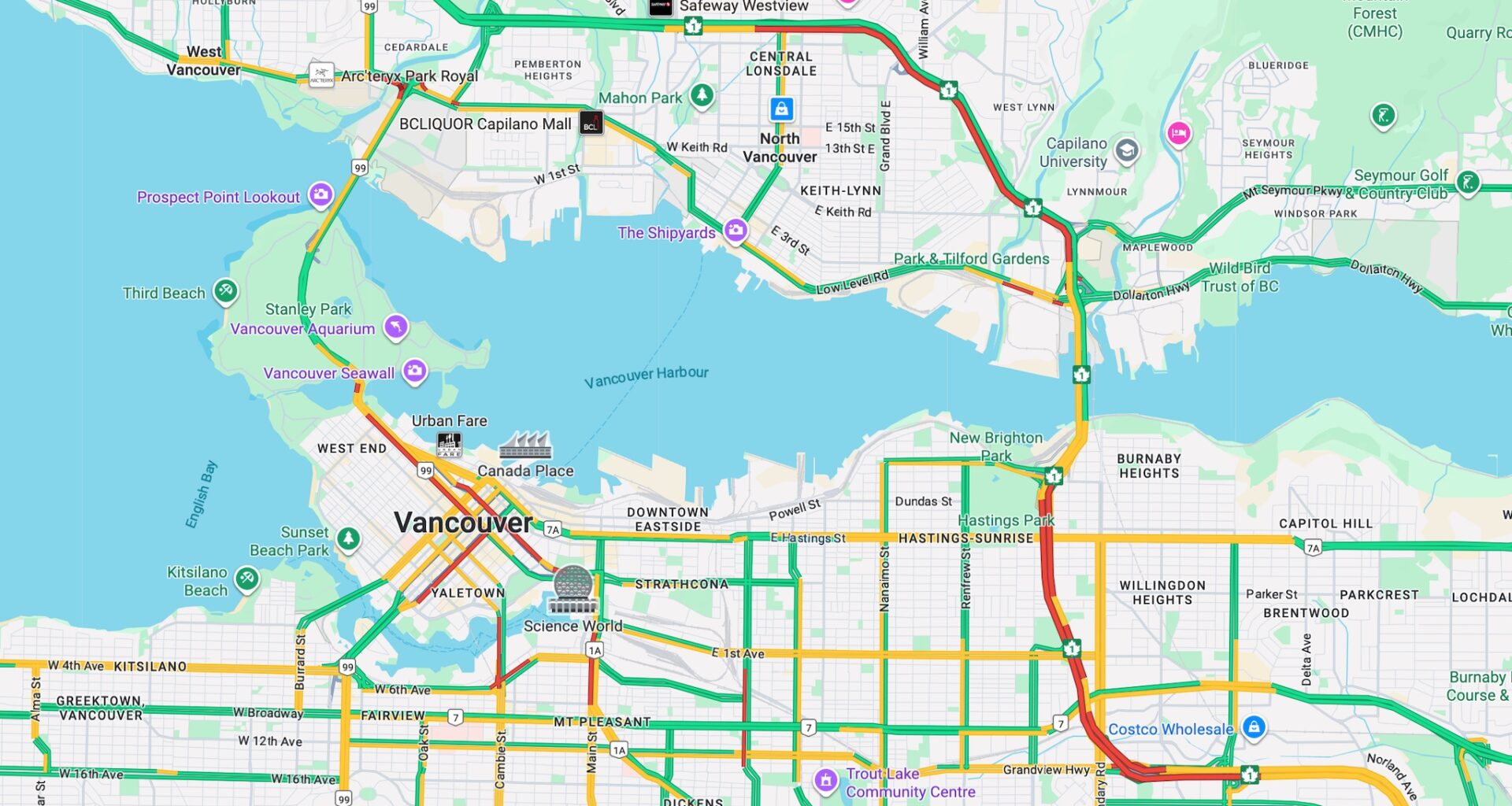Residents and businesses on the North Shore of Metro Vancouver are fed up with worsening traffic conditions, and some are now urging for meaningful new additional transportation infrastructure across Burrard Inlet.
“Living on the North Shore, traffic congestion has become an unavoidable daily hurdle. As a resident, it deeply troubles me to watch our community struggle due to outdated transportation infrastructure that fails to meet current and future demand. The simple need to get from point A to point B is turning into a monumental task,” reads a new online petition.
They are calling on the Government of British Columbia, Government of Canada, and the North Shore’s various municipal governments to take “immediate action” and assess the transportation infrastructure woes from an efficiency and safety lens.
This includes a specific plea to build a third fixed crossing across Burrard Inlet.
The Lions Gate Bridge was built in 1937, but has long been a bottleneck with its three vehicle lanes under conterflow control. The last significant transportation infrastructure built across Burrard Inlet was built in 1960, when the Ironworkers Memorial Bridge opened with six vehicle lanes.
The petition highlights how accidents and other incidents on either of the two bridges trigger a cascading failure in the region’s transportation network, quickly overwhelming the only remaining bridge and the roads leading to and from the only alternative crossing.
This complete lack of resiliency, redundancy, and predictability in the transportation network impacts emergency response, the economy, community well-being, and overall productivity. All the while, the North Shore is beginning to see more high-density residential developments that add to this transportation demand.
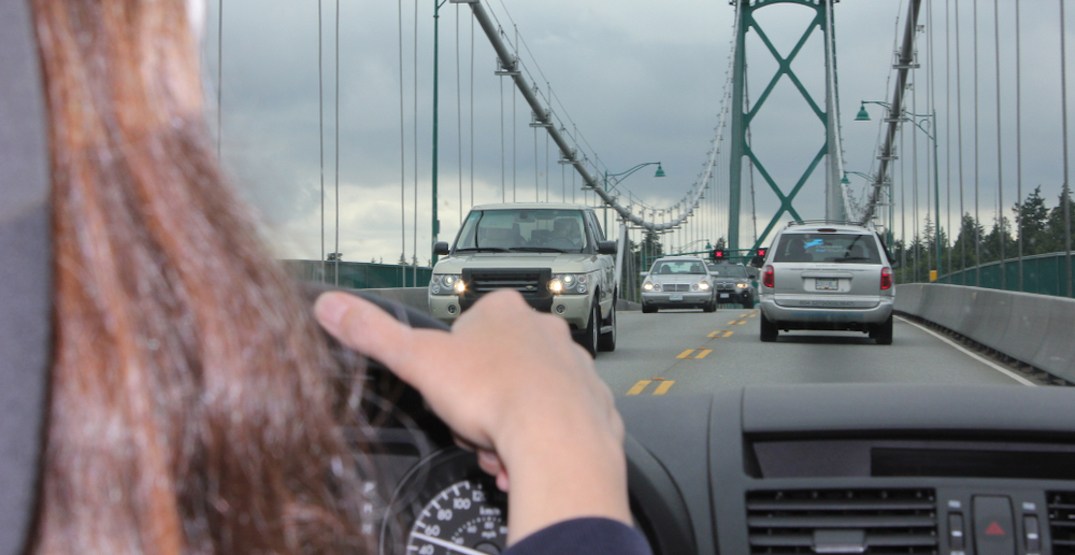
Driving on the Lions Gate Bridge. (Mary Ann Love/Shutterstock)
“The North Shore is undergoing significant growth with new housing developments being proposed and approved. However, our current roadway infrastructures fail to accommodate the increasing traffic volumes. It often takes just a single accident or minor disruption to halt traffic to a standstill. This gridlock is not merely an inconvenience; it’s a potential hazard, particularly in emergencies when response times are critical,” reads the petition.
“Adding a third crossing from the North Shore to Vancouver is not just a desire — it’s a necessity. We must prevent a situation where emergency services are delayed due to our clogged roadways. Comprehensive re-evaluation of our existing infrastructure in light of future forecasts is imperative. Traffic congestion has far-reaching effects, including increased pollution, stress levels, and decreased productivity… Streamlining our traffic not only benefits individuals but boosts the overall economy and quality of life for the community.”
Over the decades, there have been potential ideas for building a brand new Lions Gate Bridge, widening or even twinning the Lions Gate Bridge, building a new road tunnel underneath Stanley Park, and/or even building a new bridge from the foot of Vancouver’s Main Street.
“We feel like hostages in our own homes”
As of the time of writing, this petition — launched on July 31 — has already garnered over 2,600 signatures.
One supporter shared that it took them five hours to travel from Vancouver to Deep Cove to pick up their child from camp last week due to gridlock, ultimately prompting them to quit their job in Vancouver because of the transportation network’s unreliability.
While the north-south crossings over Burrard Inlet are a major choke point, significant east-west transportation challenges also exist within the North Shore itself.
Another noted that while their morning commute from North Vancouver to West Vancouver takes just nine minutes, the return trip can take up to an hour — or even longer when accidents occur.
Someone else described a recent experience in which a drive from Lonsdale to Deep Cove took 3.5 hours due to a vehicle crash at the south end of the Ironworkers Memorial Bridge, which triggered extensive backups throughout the road network.
Others said that persistent gridlock and the unreliability of the transportation system have forced them to cancel appointments, shopping trips, leisure activities, and other outings — resulting in significant opportunity costs.
One teacher reported that traffic congestion is even affecting school attendance, with some parents routinely pulling their children out of class early several days a week to ensure they can make it to after-school commitments on time.
“Traffic gridlock on the North Shore is not just an inconvenience — it has become something that dictates everyday life,” one individual wrote. “Even basic decisions — like enrolling our kids in swimming lessons or after-school activities — are impacted. The answer is often ‘no,’ because the return trip home could take three times as long, or more. We need cooperation at all levels of government to deliver meaningful solutions.”
Another stated, “We feel like hostages in our own homes most days after 2:15 p.m. until the evening. Like others have said, we’re often unable to leave our neighbourhood — or return to it.”
Some residents have turned down job opportunities or moved away from the North Shore due to worsening traffic, while others are seriously considering relocating.
And businesses cannot hire or retain staff, as many live on the south side of Burrard Inlet and do not want to deal with the congestion.
As is, many businesses and organizations and even the municipal governments on the North Shore rely on a high proportion of workers who live on the other side of the inlet due to the challenges with housing affordability and supply in the District of West Vancouver, District of North Vancouver, and City of North Vancouver. All the while, there is resistance to new housing from some local residents due to the transportation woes.
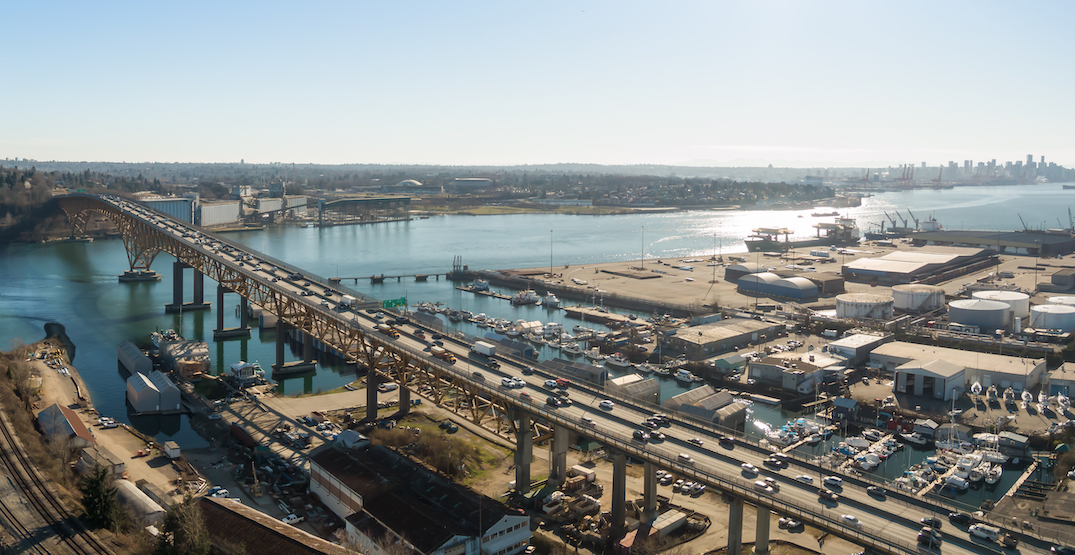
Ironworkers Memorial Bridge. (EB Adventure Photography/Shutterstock)
When the Ironworkers Memorial Bridge was built 65 years ago, the North Shore had a population of roughly 120,000 residents. Today, the population is approximately 200,000. The latest population growth forecast pushes the North Shore’s population to about 270,000 residents by 2050, not including the potential high-density developments of various large First Nation reserves, such as at the northern end of the Ironworkers Memorial Bridge.
Future plans for Bus Rapid Transit; calls for SkyTrain
Currently, the Lions Gate Bridge carries an average of approximately 56,000 vehicles per day — a capacity increasingly impacted by the City of Vancouver’s changes to downtown Vancouver’s road network over the past 15 years. In contrast, the Ironworkers Memorial Bridge, as a segment of the Highway 1 freeway, handles more than 120,000 vehicles daily, underscoring its importance in the region.
Moreover, in recent decades, both bridges have experienced increased vehicle traffic due to a combination of factors: rising leisure and recreational travel to the North Shore and nearby mountain destinations, growing tourism along the Sea to Sky Highway to Whistler, expanding commuter patterns from new residential developments in Squamish that have turned the community into a suburb of Metro Vancouver, and heavier volumes heading to BC Ferries’ Horseshoe Bay terminal — one of only two ferry routes connecting the Lower Mainland to Vancouver Island.
For the month of June 2025, Horseshoe Bay ferry terminal saw a total of over 385,000 vehicles and 1.08 million passengers across all three of its ferry routes, including 212,000 vehicles and 645,000 passengers on the major route reaching Departure Bay in Nanaimo.
SeaBus, launched in 1977, offers a passenger-only public transit ferry service between Lonsdale Quay and downtown Vancouver. TransLink’s 2024 data shows an average daily SeaBus ridership of approximately 16,800 boardings on weekdays, 17,200 on Saturdays, and 13,400 on Sundays/holidays. Thousands more cross Burrard Inlet each day using various bus routes that utilize the bridges.
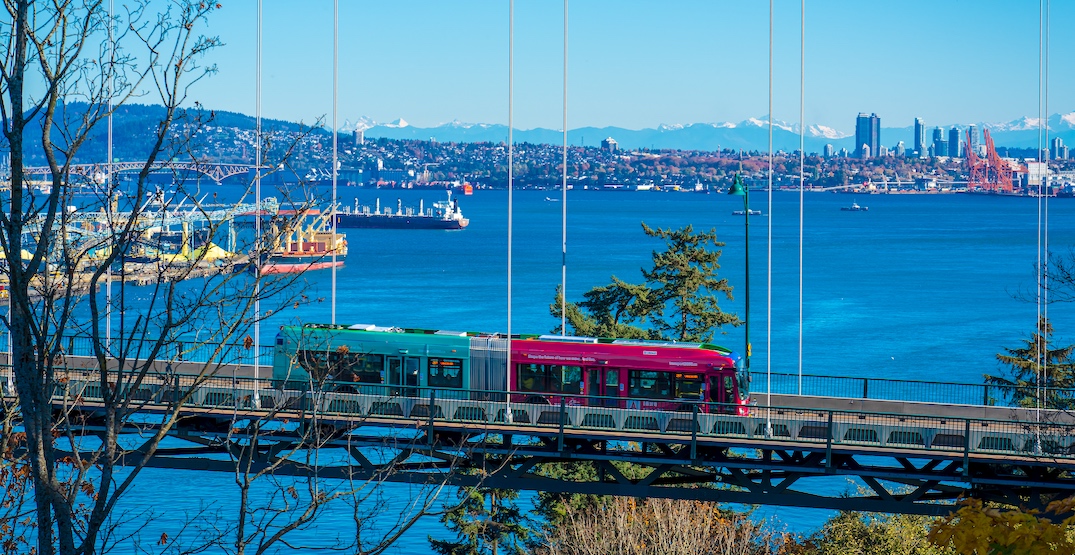
TransLink bus on the Lions Gate Bridge. (Lee Liu/Shutterstock)
TransLink has plans to extend the R2 Marine Drive RapidBus route in 2027 to reach SkyTrain’s Brentwood Town Centre Station and Metrotown Station in Burnaby via the Ironworkers Memorial Bridge. Currently, the R2 runs east-west within the North Shore between Park Royal mall and Phibbs bus exchange.
Due to road congestion and travel times that are often uncompetitive with driving, the R2 has relatively low ridership for a RapidBus service. In 2024, it recorded an average of 5,700 boardings per weekday, 5,000 on Saturdays, and 4,000 on Sundays and holidays. Among the region’s six RapidBus routes, the R2 was the second least busy, ranking 42nd overall among all bus routes in Metro Vancouver.
The public transit authority is also exploring the potential future conversion of the R2 RapidBus into a Bus Rapid Transit (BRT) service, which would involve reallocating general traffic lanes on the North Shore’s arterial roads to create physically separated, bus-only lanes. BRT is seen as a possible stepping stone toward longer-term transit solutions, such as Light Rail Transit (LRT) or SkyTrain. TransLink has indicated it will study these permanent options as part of its long-term planning.
However, some have advocated for planning a SkyTrain extension from the outset, rather than first investing in costly and time-intensive temporary solutions like BRT or LRT. They argue that starting with SkyTrain would provide future-proof, high-capacity rapid transit option, avoid the costs and disruptions of multiple infrastructure upgrades, and garner significant public support.
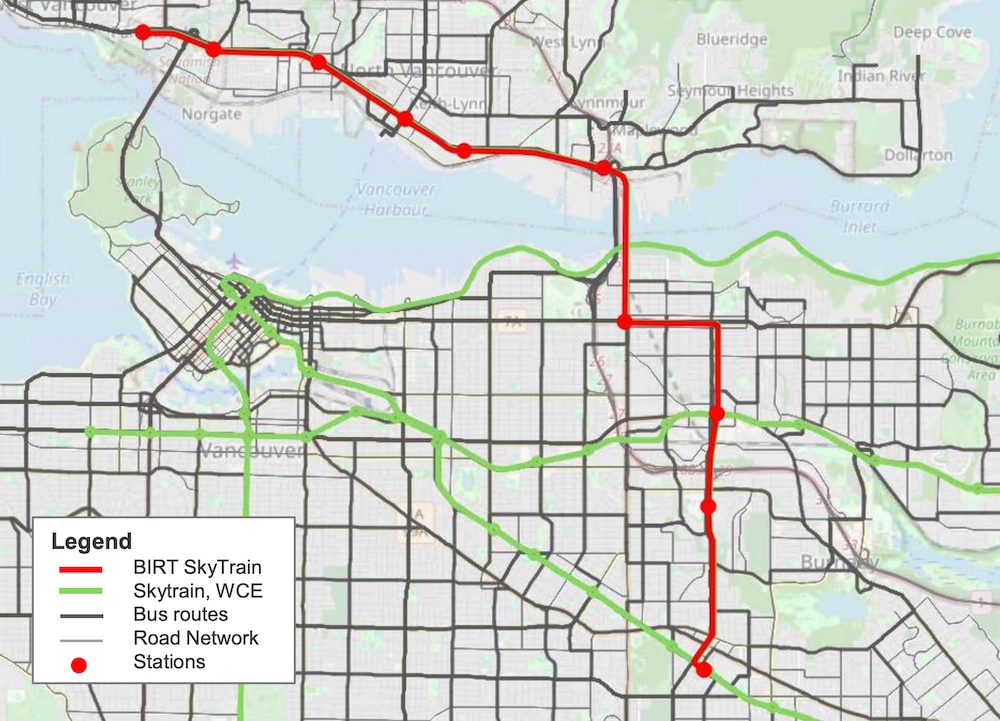
SkyTrain concept for the Burrard Inlet Rapid Transit Line. (McElhanney/District of North Vancouver)
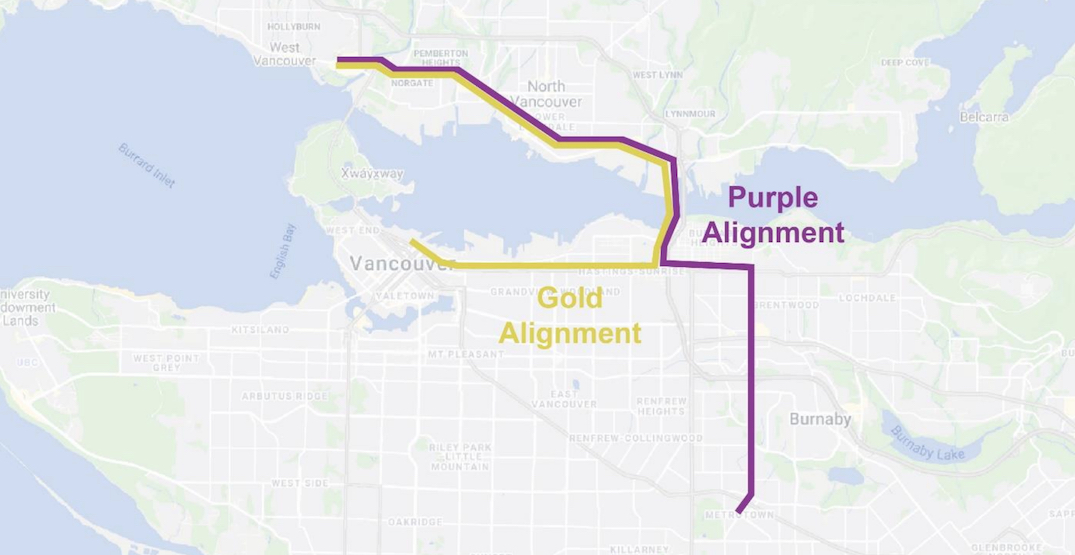
Burrard Inlet Rapid Transit concepts of two North Shore SkyTrain lines via the Second Narrows: Gold Line from Park Royal to downtown Vancouver via Hastings, and Purple Line from Park Royal to Brentwood Town Centre Station and Metrotown Station via Willingdon Avenue. (North Shore Connects)
Some municipal studies conducted recently also suggest tying a rail rapid transit link with a project to build a brand new Ironworkers Memorial Bridge, which is now beginning to approach the end of its lifespan.
Furthermore, highly preliminary analysis shows SkyTrain between Park Royal and Metrotown via a new bridge at the Second Narrows could have a travel time of only about 23 minutes, and see very high ridership volumes of 120,000 per day.
The provincial government also recently completed a study considering long-term capacity and safety upgrades for the Upper Levels Highway on the North Shore.
